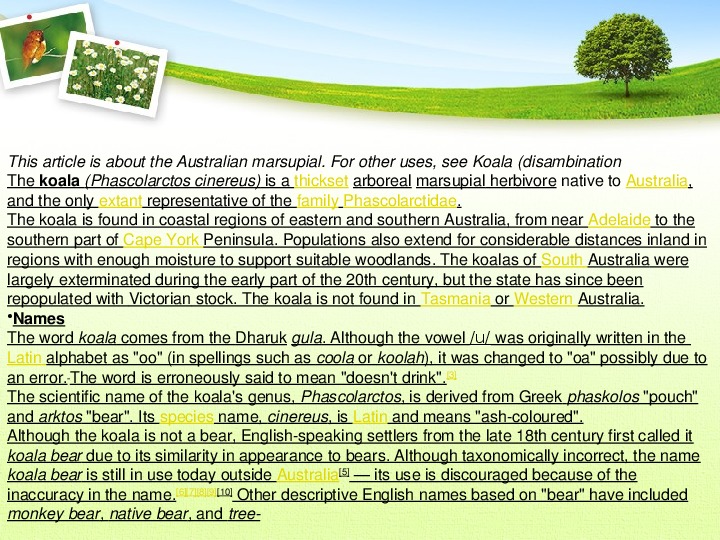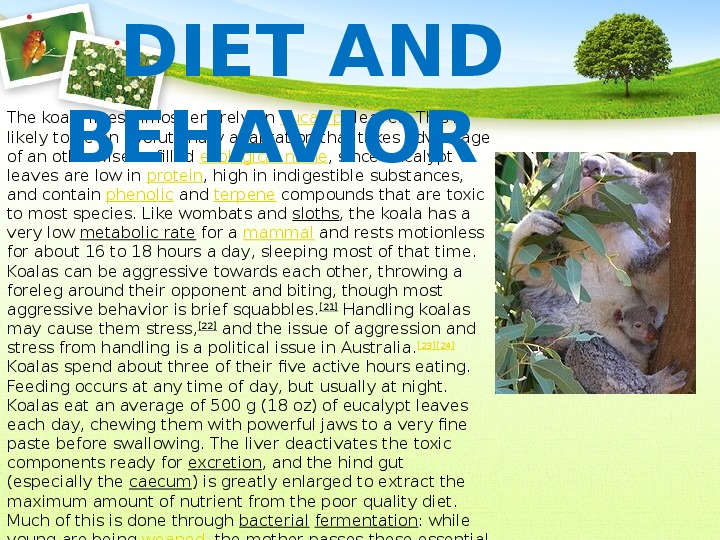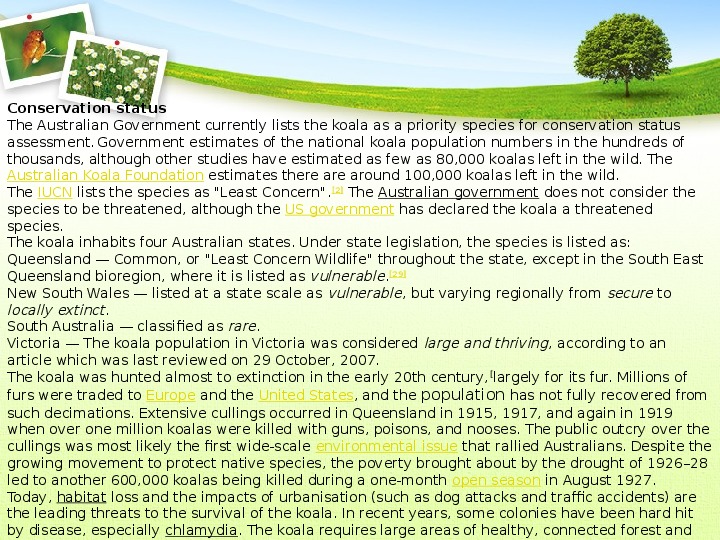Презентация по англ яз "животные в Австралии" перенесет вас в мир животных в Австралии, содержит в себе много интересных, увлекательных и разноуровневых заданий, что прекрасно будет выполнят индивидуальный подход к каждому ребенку, много также красивых высказываний и текстов адапрированных для детей
Australian animals
KOALAS and POSSUMS
KOALA
Phascolarctos cinereus

This article is about the Australian marsupial. For other uses, see Koala (disambination
The koala (Phascolarctos cinereus) is a thickset arboreal marsupial herbivore native to Australia,
and the only extant representative of the family Phascolarctidae.
The koala is found in coastal regions of eastern and southern Australia, from near Adelaide to the
southern part of Cape York Peninsula. Populations also extend for considerable distances inland in
regions with enough moisture to support suitable woodlands. The koalas of South Australia were
largely exterminated during the early part of the 20th century, but the state has since been
repopulated with Victorian stock. The koala is not found in Tasmania or Western Australia.
•Names
The word koala comes from the Dharuk gula. Although the vowel /u/ was originally written in the
Latin alphabet as "oo" (in spellings such as coola or koolah), it was changed to "oa" possibly due to
an error. The word is erroneously said to mean "doesn't drink".[3]
The scientific name of the koala's genus, Phascolarctos, is derived from Greek phaskolos "pouch"
and arktos "bear". Its species name, cinereus, is Latin and means "ashcoloured".
Although the koala is not a bear, Englishspeaking settlers from the late 18th century first called it
koala bear due to its similarity in appearance to bears. Although taxonomically incorrect, the name
koala bear is still in use today outside Australia[5] — its use is discouraged because of the
inaccuracy in the name.[6][7][8][9][10] Other descriptive English names based on "bear" have included
monkey bear, native bear, and tree
The koala is broadly similar in appearance to the
wombat (its closest living relative), but has a thicker
coat, much larger ears, and longer limbs. The koala
has large, sharp claws to assist with climbing tree
trunks. Weight varies from about 14 kg (31 lb) for a
large southern male, to about 5 kg (11 lb) for a small
northern female. The koala's five fingers are arranged
with opposable thumbs, providing better gripping
ability. The first two fingers are positioned in
apposition on the front paws, and the first three
fingers for the hind paws. The koala is one of the few
mammals (other than primates) that has fingerprints.
Koala fingerprints are similar to human fingerprints;
even with an electron microscope, it can be quite
difficult to distinguish between the two.
.
Koala
and
baby
on
back.

DIET AND
BEHAVIOR
The koala lives almost entirely on eucalypt leaves. This is
likely to be an evolutionary adaptation that takes advantage
of an otherwise unfilled ecological niche, since eucalypt
leaves are low in protein, high in indigestible substances,
and contain phenolic and terpene compounds that are toxic
to most species. Like wombats and sloths, the koala has a
very low metabolic rate for a mammal and rests motionless
for about 16 to 18 hours a day, sleeping most of that time.
Koalas can be aggressive towards each other, throwing a
foreleg around their opponent and biting, though most
aggressive behavior is brief squabbles.[21] Handling koalas
may cause them stress,[22] and the issue of aggression and
stress from handling is a political issue in Australia.[23][24]
Koalas spend about three of their five active hours eating.
Feeding occurs at any time of day, but usually at night.
Koalas eat an average of 500 g (18 oz) of eucalypt leaves
each day, chewing them with powerful jaws to a very fine
paste before swallowing. The liver deactivates the toxic
components ready for excretion, and the hind gut
(especially the caecum) is greatly enlarged to extract the
maximum amount of nutrient from the poor quality diet.
Much of this is done through bacterial fermentation: while
young are being weaned, the mother passes these essential

Conservation status
The Australian Government currently lists the koala as a priority species for conservation status
assessment. Government estimates of the national koala population numbers in the hundreds of
thousands, although other studies have estimated as few as 80,000 koalas left in the wild. The
Australian Koala Foundation estimates there are around 100,000 koalas left in the wild.
The IUCN lists the species as "Least Concern".[2] The Australian government does not consider the
species to be threatened, although the US government has declared the koala a threatened
species.
The koala inhabits four Australian states. Under state legislation, the species is listed as:
Queensland — Common, or "Least Concern Wildlife" throughout the state, except in the South East
Queensland bioregion, where it is listed as vulnerable.[29]
New South Wales — listed at a state scale as vulnerable, but varying regionally from secure to
locally extinct.
South Australia — classified as rare.
Victoria — The koala population in Victoria was considered large and thriving, according to an
article which was last reviewed on 29 October, 2007.
The koala was hunted almost to extinction in the early 20th century,[largely for its fur. Millions of
furs were traded to Europe and the United States, and the population has not fully recovered from
such decimations. Extensive cullings occurred in Queensland in 1915, 1917, and again in 1919
when over one million koalas were killed with guns, poisons, and nooses. The public outcry over the
cullings was most likely the first wide-scale environmental issue that rallied Australians. Despite the
growing movement to protect native species, the poverty brought about by the drought of 1926–28
led to another 600,000 koalas being killed during a one-month open season in August 1927.
Today, habitat loss and the impacts of urbanisation (such as dog attacks and traffic accidents) are
the leading threats to the survival of the koala. In recent years, some colonies have been hard hit
by disease, especially chlamydia. The koala requires large areas of healthy, connected forest and
will travel long distances along tree corridors in search of new territory and mates. The increasing
310000
300000
290000
280000
270000
260000
250000
240000
230000
220000
300000
290000
280000
250000
1810
1910
2000
2010
I wish
I
could
help
them
and
ban
hunti
ng
the
koala
s!
Part IV
The aim of the Foundation for Australia’s Most
Endangered Species (FAME) is to prevent
any further extinctions of Australian wildlife.
They actively support projects that will save
endangered wildlife, and work in partnership
with many organizations. It was founded in
Australia in 1993. The headquarters’ is
situated in Mitchem, South Australia. The
members of FAME are volunteers who want
to help to save endangered animals. They
prefer to work with organizations that manage
protected areas where native species can live
naturally in their natural environment, safe
from threats of habitat destroy and
competitors.
.Designed by Vladimir
Created By Nick
Please save
Koalas and
possums!!!!
